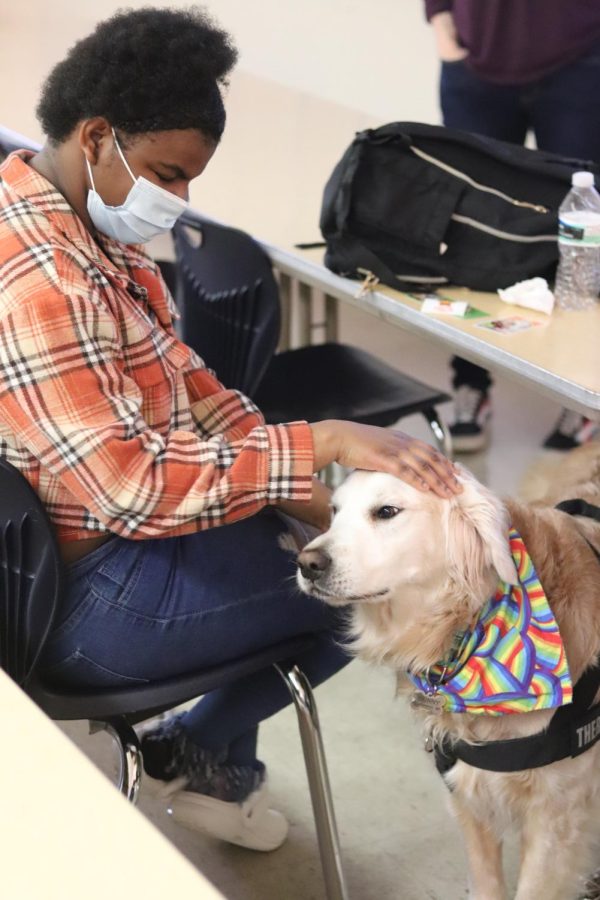Certified therapy dog, Sunny, visits Loy Norrix classroom

April 28, 2022
People know the saying “a dog is man’s best friend.” But dogs might become students’ best friends as well. On Wednesday, April 6, there was a furry friend in Loy Norrix English teacher Lisa Jenson’s and Anna Gutman’s classroom. A therapy dog named Sunny visited her classroom along with his handler, Dr. Angie Moe.
“The dog is so cute, and really smart. He’s so friendly and loves everyone, ” said junior Jiselle Anderson.
Dr. Moe is a professor of sociology at Western Michigan University and a certified in animal assisted therapy. She was invited by Jenson to talk to her classes about therapy animals and ways to take care of your mental health. Dr. Moe also brought her furry companion, Sunny.
Sunny is a six-year-old Golden Retriever that is being trained by Dr. Moe. He is certified through the Alliance of Therapy Dogs, an organization with over 50 thousand therapy dogs in the US, and also trained in crisis response. In order for Sunny to be a therapy dog, he must be very calm and good with people. Despite this experience, Dr. Moe believes Sunny will never be done training.
“I don’t ever say we’re done [training], especially when he gets older. Now he’s middle aged, so I suspect he’ll show preference to different settings, and I’m going to have to pick up on that and honor that. So we’re always learning,” Dr. Moe said.
While in Jenson’s room, Sunny wandered around while students petted him. Dr. Moe gave a presentation about herself and Sunny along with facts and information about being a service dog and being the handler of a service dog.
One of the topics that Dr. Moe covered in her presentation was the difference between service and therapy dogs. Therapy dogs and service dogs are different in a few ways. Service dogs are trained to perform tasks for their handler that they are unable to do themselves, while a therapy dog is trained to bring comfort and joy to people at places such as school, work or hospitals. There are also emotional support animals that provide support and comfort to a handler with a mental illness.
Dr. Moe also talked about the different types of therapy animals. For instance, dogs aren’t the only therapy animals, though they are the most popular. Other animals include cats, rabbits, birds, miniature horses, alpacas, pigs and llamas.
Therapy dogs are very well trained and hard working. When therapy dogs are “working” they must remain calm and behave accordingly. Sunny is not allowed to bark, run, whine or lick people while he is working, as it is deemed inappropriate. The only time Sunny is allowed to bark is if he detects an emergency or potential threat.
As a therapy dog, Sunny has a few responsibilities to take care of, especially behaving while being groomed by Dr. Moe on a daily basis.
“He has to tolerate being groomed and being nice and clean so he gets baths everyday. He gets wiped down after every visit and brushed all the time. I have to clean his teeth and ears. He also needs to be okay with putting on all his equipment and riding in a car,” Moe said.
Dr. Moe and Sunny travel a lot to areas in need of a therapy dog, some as far as multiple hours away. Sunny must also be patient because he could also be working multiple straight hours.
Sunny was enjoyed by the class during Dr. Moe’s presentation and also after class.
“I was having a bad day and he brightened up my day,” said junior Percy Gordan.
Everyone in the room seemed to have been in a better mood when Sunny would come near them. People would scratch his head and pet his sides, Sunny would instantly cheer up peoples day.
“I really enjoyed him in class, it lifted everyone’s spirits,” Anderson said.













Trissten Shermaan • Apr 30, 2022 at 6:02 am
Difference between Emotional Support, PTSD, Therapy and Service Dogs
Know more: https://bit.ly/3y5NhUk